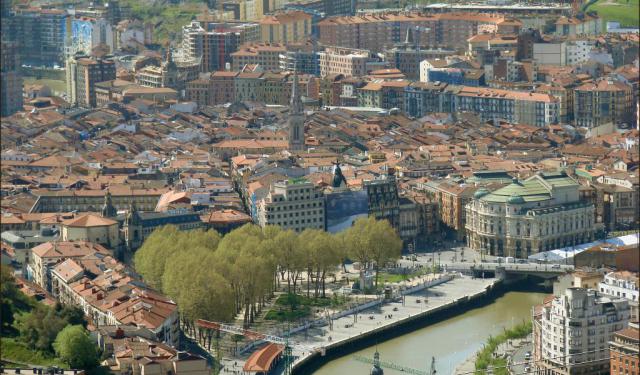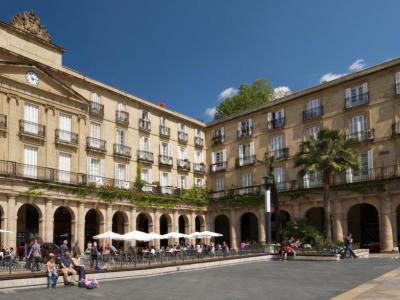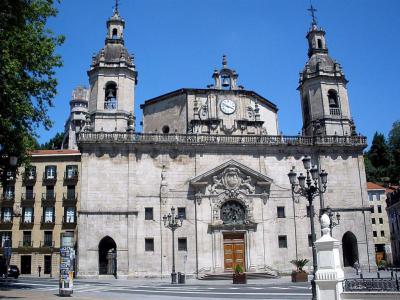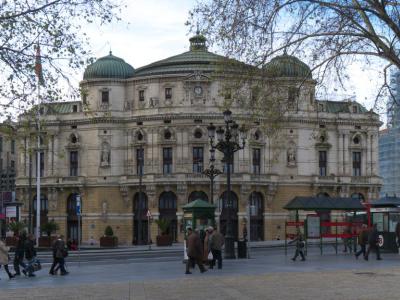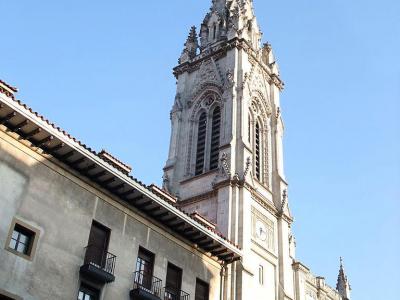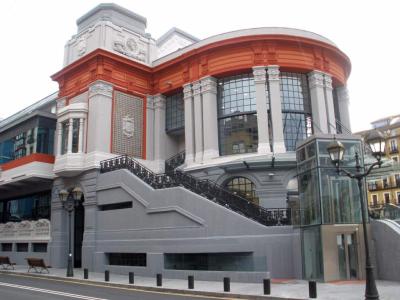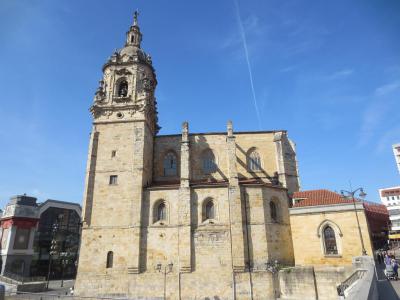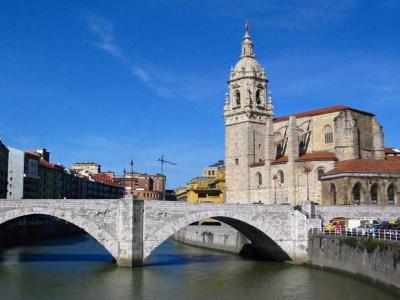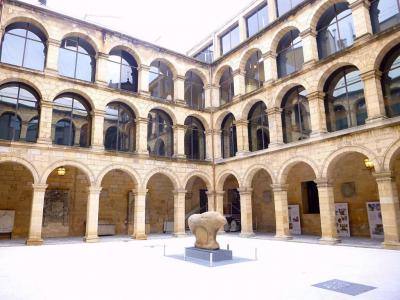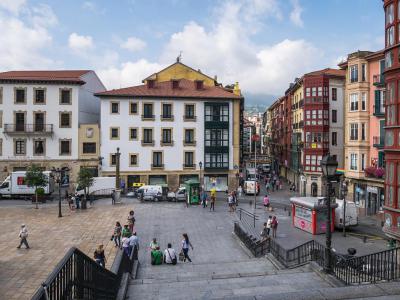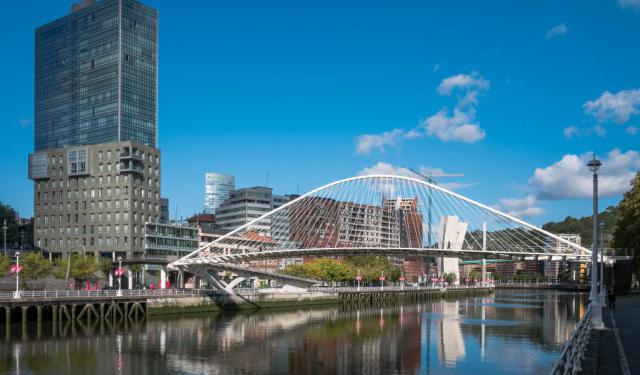Bilbao's Old Town Walking Tour (Self Guided), Bilbao
Bilbao's old town, also known as The Seven Streets, is the medieval heart of the city. Indeed, this ancient neighborhood, a place where the city began and which had been fortified by walls until the late 19th century, today consists of seven main streets and many narrow alleys – called cantons (kantoi, cantón) – that connect them.
Often regarded as a jewel of Basque architecture and cuisine, the up-and-coming Old Town remains one of Bilbao's most visited areas. In large part, this is due to the several historical churches found here, such as the Church of Saint Anthony the Great and Church of Saint Nicholas. One of the main local attractions, undoubtedly, is the iconic 14th-century Santiago Cathedral, featuring a stunning Gothic-Renaissance façade.
Just as well, the old quarter attracts locals and tourists alike with the numerous pintxo bars where they can indulge in the region's culinary delights. For this reason, the beautiful Plaza Nueva, a hub of social life lined with cafés, bars, and restaurants, is yet another popular site in the area. There is a tradition of middle-aged men doing a tavern crawl drinking short glasses (chiquitos) of wine and singing choral songs.
Aside from great food and architecture, however, the Old Town allows visitors a chance to learn about Bilbao's vibrant history and culture. Places like the Basque Museum provide insights into the region's past, while the landmark food market, Mercado de la Ribera (Ribera Market), offers a glimpse into the daily life of the city.
For those keen on exploring all of this, a self-guided walk around the lively and colorful Old Town of Bilbao will present an incredible interest.
Often regarded as a jewel of Basque architecture and cuisine, the up-and-coming Old Town remains one of Bilbao's most visited areas. In large part, this is due to the several historical churches found here, such as the Church of Saint Anthony the Great and Church of Saint Nicholas. One of the main local attractions, undoubtedly, is the iconic 14th-century Santiago Cathedral, featuring a stunning Gothic-Renaissance façade.
Just as well, the old quarter attracts locals and tourists alike with the numerous pintxo bars where they can indulge in the region's culinary delights. For this reason, the beautiful Plaza Nueva, a hub of social life lined with cafés, bars, and restaurants, is yet another popular site in the area. There is a tradition of middle-aged men doing a tavern crawl drinking short glasses (chiquitos) of wine and singing choral songs.
Aside from great food and architecture, however, the Old Town allows visitors a chance to learn about Bilbao's vibrant history and culture. Places like the Basque Museum provide insights into the region's past, while the landmark food market, Mercado de la Ribera (Ribera Market), offers a glimpse into the daily life of the city.
For those keen on exploring all of this, a self-guided walk around the lively and colorful Old Town of Bilbao will present an incredible interest.
How it works: Download the app "GPSmyCity: Walks in 1K+ Cities" from Apple App Store or Google Play Store to your mobile phone or tablet. The app turns your mobile device into a personal tour guide and its built-in GPS navigation functions guide you from one tour stop to next. The app works offline, so no data plan is needed when traveling abroad.
Bilbao's Old Town Walking Tour Map
Guide Name: Bilbao's Old Town Walking Tour
Guide Location: Spain » Bilbao (See other walking tours in Bilbao)
Guide Type: Self-guided Walking Tour (Sightseeing)
# of Attractions: 9
Tour Duration: 1 Hour(s)
Travel Distance: 1.6 Km or 1 Miles
Author: DanaOffice
Sight(s) Featured in This Guide:
Guide Location: Spain » Bilbao (See other walking tours in Bilbao)
Guide Type: Self-guided Walking Tour (Sightseeing)
# of Attractions: 9
Tour Duration: 1 Hour(s)
Travel Distance: 1.6 Km or 1 Miles
Author: DanaOffice
Sight(s) Featured in This Guide:
- Plaza Nueva (New Square)
- Iglesia de San Nicolas (Church of Saint Nicholas)
- Teatro Arriaga (Arriaga Theatre)
- Catedral de Santiago (Santiago Cathedral)
- Mercado de la Ribera (Ribera Market)
- Iglesia de San Anton (Church of Saint Anthony the Great)
- Puente de San Anton (San Anton Bridge)
- Museo Vasco (Basque Museum)
- Plaza Miguel Unamuno (Miguel Unamuno Square)
1) Plaza Nueva (New Square) (must see)
Work on Bilbao’s New Square began in 1828, with King Fernando VII laying the first stone in person. The plan was to crown the plaza with his statue, but his death in 1833 left the honor unclaimed. A pond filled the gap until 1890, when López de Haro-the city’s 14th-century founder-finally claimed the pedestal. After years of hesitation and revision, the square itself opened in 1851.
The idea had been brewing since the late 1700s, when city leaders wanted a space that could match the grand plazas of Madrid or Salamanca. Architect Antonio de Echevarría delivered with a design that was as orderly as it was ambitious: a neoclassical rectangle framed by arcades, giving the old quarter a stage for modern civic life. Its name, “New Square,” underscored the break with the rambling medieval markets of the Seven Streets.
Askao, Sombrerería, Fueros, and Correo Streets define its edges, while 64 arches frame the interiors with bars, shops, and offices. The Basque government once held court here, until 1890 when the Royal Academy of the Basque Language made the square its home. Throughout the 19th century, New Square embodied Bilbao’s leap into modernity. Commerce thrived under the arches, while the open space saw political rallies, concerts, and festivals that pulled the community together.
The tradition hasn’t faded. Sundays bring a flea market where locals bargain over coins, stamps, antiques, and even birds or flowers. Wi-Fi arrived in 2008, a small reminder that the square continues to adapt, just as pintxos bars keep the flavors of Bilbao rooted in place. Two centuries on, New Square remains both ordered geometry and lived-in history-the kind of plaza that tells its story as much through the chatter under the arches as through the symmetry of its stones.
The idea had been brewing since the late 1700s, when city leaders wanted a space that could match the grand plazas of Madrid or Salamanca. Architect Antonio de Echevarría delivered with a design that was as orderly as it was ambitious: a neoclassical rectangle framed by arcades, giving the old quarter a stage for modern civic life. Its name, “New Square,” underscored the break with the rambling medieval markets of the Seven Streets.
Askao, Sombrerería, Fueros, and Correo Streets define its edges, while 64 arches frame the interiors with bars, shops, and offices. The Basque government once held court here, until 1890 when the Royal Academy of the Basque Language made the square its home. Throughout the 19th century, New Square embodied Bilbao’s leap into modernity. Commerce thrived under the arches, while the open space saw political rallies, concerts, and festivals that pulled the community together.
The tradition hasn’t faded. Sundays bring a flea market where locals bargain over coins, stamps, antiques, and even birds or flowers. Wi-Fi arrived in 2008, a small reminder that the square continues to adapt, just as pintxos bars keep the flavors of Bilbao rooted in place. Two centuries on, New Square remains both ordered geometry and lived-in history-the kind of plaza that tells its story as much through the chatter under the arches as through the symmetry of its stones.
2) Iglesia de San Nicolas (Church of Saint Nicholas)
The Church of Saint Nicolas, a Catholic Church that opened in 1756, was designed by architect Ignacio Ibero. It is in Saint Nicholas Square (Plaza de San Nicolas), facing the Arriaga Theater. The original church, built close to the estuary in 1490, was eventually ruined by flooding.
Ibero's basic design in the 1743 plan was a large circle within a square. The presbytery and the main entry are on one axis. The two side entrances are on a perpendicular axis, which creates exedras at the corners of the square. The four exedras hold two altarpieces joined by two tribunes and a choir.
The principal facade is topped by a balustrade and flanked by twin towers. The Belfry, centered over the main entrance, partly conceals the octagonal drum under the dome with oculi. A bronze tympanum by sculptor Josep Llimona depicts Saint Nicolas amongst fisherfolk. Above the tympanum is the coat of arms of the Town Council.
Inside is an unusual set of five Rococo altarpieces. Designed in 1752 by architect Diego Martinez de Arce, they display ornate carvings and reliefs. The altarpieces are dedicated to the saints Crispin, Crispiniano, Lazaro, Blaise, and La Piedad.
In the chapel of the Virgin of Guadalupe, there is an 18th-century painting of the Virgin. There is also a relief of The Visitation and an image of San Judas Tadeo, a favorite saint of Bilbao.
Ibero's basic design in the 1743 plan was a large circle within a square. The presbytery and the main entry are on one axis. The two side entrances are on a perpendicular axis, which creates exedras at the corners of the square. The four exedras hold two altarpieces joined by two tribunes and a choir.
The principal facade is topped by a balustrade and flanked by twin towers. The Belfry, centered over the main entrance, partly conceals the octagonal drum under the dome with oculi. A bronze tympanum by sculptor Josep Llimona depicts Saint Nicolas amongst fisherfolk. Above the tympanum is the coat of arms of the Town Council.
Inside is an unusual set of five Rococo altarpieces. Designed in 1752 by architect Diego Martinez de Arce, they display ornate carvings and reliefs. The altarpieces are dedicated to the saints Crispin, Crispiniano, Lazaro, Blaise, and La Piedad.
In the chapel of the Virgin of Guadalupe, there is an 18th-century painting of the Virgin. There is also a relief of The Visitation and an image of San Judas Tadeo, a favorite saint of Bilbao.
3) Teatro Arriaga (Arriaga Theatre)
Juan Crisostomo de Arriaga y Balzola, a brilliant Basque composer known as "the Spanish Mozart," died at the age of twenty. He was born on the same day as Mozart, 27 January, but fifty years later. Only fragments of his extraordinary works remain. The Neo-Baroque opera house, Arriaga Theatre, was built in 1890 and was dedicated to his memory.
The original opera house of 1890, known as the New Bilbao Theater, was built by architect Joaquin Rucoba, who also designed the Bilbao City Hall. The New Bilbao Theater soon took the name Arriaga Theater from Arriaga Square, where it was located.
Rucoba's design combined classical decoration with every technological advance available at the time. In 1890, the opera La Gioconda, by Italian composer Amilcare Ponchielli, marked the inauguration. A fire destroyed the building in 1914. Reconstruction was directed by architect and urban planner Federico Ugalde.
The theater today is a free-standing edifice with three divided elevations. The base level has pillar-supported enclosed arches topped by a continuous cornice. The second level holds the main "noble" floor with rectangular openings and decorated oculi. The third-level cornice has a railing and smaller rectangular windows.
The main facade is curved-convex. It is flanked by twin turrets. The side and rear exteriors have balconies supported by "Atlantean" corbels. The turrets have domes. The roof is sloping by mansards surrounding the building.
The original opera house of 1890, known as the New Bilbao Theater, was built by architect Joaquin Rucoba, who also designed the Bilbao City Hall. The New Bilbao Theater soon took the name Arriaga Theater from Arriaga Square, where it was located.
Rucoba's design combined classical decoration with every technological advance available at the time. In 1890, the opera La Gioconda, by Italian composer Amilcare Ponchielli, marked the inauguration. A fire destroyed the building in 1914. Reconstruction was directed by architect and urban planner Federico Ugalde.
The theater today is a free-standing edifice with three divided elevations. The base level has pillar-supported enclosed arches topped by a continuous cornice. The second level holds the main "noble" floor with rectangular openings and decorated oculi. The third-level cornice has a railing and smaller rectangular windows.
The main facade is curved-convex. It is flanked by twin turrets. The side and rear exteriors have balconies supported by "Atlantean" corbels. The turrets have domes. The roof is sloping by mansards surrounding the building.
4) Catedral de Santiago (Santiago Cathedral) (must see)
Santiago Cathedral holds the honor of being Bilbao’s oldest surviving monument and the city’s chief religious landmark. Dedicated to Saint James the Apostle, its very name is tied to the famed Way of Saint James, for Bilbao once sat along one of the pilgrimage routes leading to Santiago de Compostela. The first church here rose in the 14th century, only a few years after the port town was founded, and like the city around it, the building has been reshaped by fires, floods, and the passage of time. What survives is a layered mix of Gothic foundations and later renovations, each leaving its own mark.
At its heart, the cathedral is Gothic through and through. Pointed arches, ribbed vaults, and a soaring spire dominate the old town skyline. Laid out in a Latin cross plan and consecrated in 1379, it holds three naves, an ambulatory around the presbytery, and a cloister that once gave the clergy respite from the bustle outside. Sixteen chapels fill the interior, some small and intimate, others richly adorned with altars and statues, each speaking to different eras of devotion. The cloister garden, enclosed by vaulted bays, still offers a measure of peace amid the surrounding Casco Viejo.
The centuries brought new details without erasing the Gothic core. In the 19th century, architect Severino de Achucarro added a Neo-Gothic façade, spire, and rose window. The main entrance is flanked by Saints Peter and Paul, while the 16th-century Angel Gate depicts Saint James guiding pilgrims. To the south, a broad portico built over an old necropolis in 1580 doubles as structural support and as another showcase of Gothic stonework.
For today’s visitor, the cathedral is not just about worship-it is a cornerstone of Bilbao’s story. Rising in the heart of the medieval quarter, it links the city’s modest beginnings as a 14th-century port to its present as a cultural hub. Pilgrims still pause for blessings, and travelers can wander through chapels and cloisters where stone and sculpture preserve centuries of faith, memory, and resilience.
At its heart, the cathedral is Gothic through and through. Pointed arches, ribbed vaults, and a soaring spire dominate the old town skyline. Laid out in a Latin cross plan and consecrated in 1379, it holds three naves, an ambulatory around the presbytery, and a cloister that once gave the clergy respite from the bustle outside. Sixteen chapels fill the interior, some small and intimate, others richly adorned with altars and statues, each speaking to different eras of devotion. The cloister garden, enclosed by vaulted bays, still offers a measure of peace amid the surrounding Casco Viejo.
The centuries brought new details without erasing the Gothic core. In the 19th century, architect Severino de Achucarro added a Neo-Gothic façade, spire, and rose window. The main entrance is flanked by Saints Peter and Paul, while the 16th-century Angel Gate depicts Saint James guiding pilgrims. To the south, a broad portico built over an old necropolis in 1580 doubles as structural support and as another showcase of Gothic stonework.
For today’s visitor, the cathedral is not just about worship-it is a cornerstone of Bilbao’s story. Rising in the heart of the medieval quarter, it links the city’s modest beginnings as a 14th-century port to its present as a cultural hub. Pilgrims still pause for blessings, and travelers can wander through chapels and cloisters where stone and sculpture preserve centuries of faith, memory, and resilience.
5) Mercado de la Ribera (Ribera Market) (must see)
Ribera Market, stretched along the Nervión in Bilbao’s Old Town, has been the city’s pantry for more than six centuries. Its story begins in the 14th century, when farmers and fishermen crowded the riverbank with stalls, feeding the young port and earning it the reputation of being the “nerve center” of town. By the 1800s, the bustle had grown so constant that writer Emiliano de Arriaga described it as “a well-stocked market with whatever the most refined gourmet could desire.” To match this abundance, an iron-and-glass hall was raised, giving the trade a permanent home.
The leap into modernity came in 1928, when architect Pedro de Ispizua drew up a Rationalist design that opened the market to light and air. Completed in 1929, it spanned more than 10,000 square meters, at the time the largest covered food market in Europe and eventually a Guinness record holder. Reinforced concrete replaced stone, while broad stained-glass windows, latticework, and Art Deco details softened its industrial bulk. From the river it resembled a floating pavilion, a deliberate nod to the estuary that had always sustained the city’s trade. Its terraces connected naturally to the San Antón Bridge and the Seven Streets, weaving the market into the daily rhythm of the Old Town.
The stalls never fell silent. Through wars, recessions, and renovations, the ground floor continued to smell of salt and fish, the first floor of cured meats and pastries, the upper level of fruit, vegetables, and flowers brought in from nearby villages. The 21st century added a new layer: wine counters, pintxo bars, and even jazz drifting through the arcades, without erasing the essential character of the place.
Ribera Market is less about shopping lists than about history you can taste. Each stall, each beam of stained glass, tells part of Bilbao’s journey from medieval riverside fair to modern urban hub. To walk inside is to see how a city feeds itself-not just with produce, but with continuity, character, and the stubborn energy of its people.
The leap into modernity came in 1928, when architect Pedro de Ispizua drew up a Rationalist design that opened the market to light and air. Completed in 1929, it spanned more than 10,000 square meters, at the time the largest covered food market in Europe and eventually a Guinness record holder. Reinforced concrete replaced stone, while broad stained-glass windows, latticework, and Art Deco details softened its industrial bulk. From the river it resembled a floating pavilion, a deliberate nod to the estuary that had always sustained the city’s trade. Its terraces connected naturally to the San Antón Bridge and the Seven Streets, weaving the market into the daily rhythm of the Old Town.
The stalls never fell silent. Through wars, recessions, and renovations, the ground floor continued to smell of salt and fish, the first floor of cured meats and pastries, the upper level of fruit, vegetables, and flowers brought in from nearby villages. The 21st century added a new layer: wine counters, pintxo bars, and even jazz drifting through the arcades, without erasing the essential character of the place.
Ribera Market is less about shopping lists than about history you can taste. Each stall, each beam of stained glass, tells part of Bilbao’s journey from medieval riverside fair to modern urban hub. To walk inside is to see how a city feeds itself-not just with produce, but with continuity, character, and the stubborn energy of its people.
6) Iglesia de San Anton (Church of Saint Anthony the Great)
The Church of Saint Anthony the Great is a Catholic church in the Old Town district of Bilbao. The church is an example of the Gothic style of church architecture, favored in the 15th and 16th centuries. Despite reconstructions, it remains possible to observe some Gothic features.
At the time of its consecration in 1433, the Church of Saint Anthony the Great had a single nave with a vaulted roof. It was enlarged in 1478. The enlarged portion was in the Gothic style. The edifice went through floods and civil disturbances, especially during the Carlist Wars. In the 19th century, it was used for arms storage. Restorations were made in 1881.
The effect of all the restorations has produced an eclectic appearance. The facade is in the 16th-century Renaissance style, whereas most of the building is Gothic. The earliest Romanesque style features the round arches of the entrance. The nave ceiling, with its ribbed vaults, is Gothic. Corinthian columns flank the entry.
Figures of Saints Peter and Paul are in niches at the doorway. The present belfry tower was done by architect Gabriel de Capelastegui. It is a Baroque four-sided tower below the ornate belfry, topped by a dome and lantern.
The church has three chapels. The Chapel of Provost has two altarpieces dedicated to Sant Ana and the Virgin of Consolation. The Chapel of Piety is Gothic, with an arch and a ribbed vault. The smallest chapel is the Chapel of San Roque. It has a ribbed vault, a Gothic arch, and sculptures of San Roque, Saint Lucy, and Saint Sebastian.
At the time of its consecration in 1433, the Church of Saint Anthony the Great had a single nave with a vaulted roof. It was enlarged in 1478. The enlarged portion was in the Gothic style. The edifice went through floods and civil disturbances, especially during the Carlist Wars. In the 19th century, it was used for arms storage. Restorations were made in 1881.
The effect of all the restorations has produced an eclectic appearance. The facade is in the 16th-century Renaissance style, whereas most of the building is Gothic. The earliest Romanesque style features the round arches of the entrance. The nave ceiling, with its ribbed vaults, is Gothic. Corinthian columns flank the entry.
Figures of Saints Peter and Paul are in niches at the doorway. The present belfry tower was done by architect Gabriel de Capelastegui. It is a Baroque four-sided tower below the ornate belfry, topped by a dome and lantern.
The church has three chapels. The Chapel of Provost has two altarpieces dedicated to Sant Ana and the Virgin of Consolation. The Chapel of Piety is Gothic, with an arch and a ribbed vault. The smallest chapel is the Chapel of San Roque. It has a ribbed vault, a Gothic arch, and sculptures of San Roque, Saint Lucy, and Saint Sebastian.
7) Puente de San Anton (San Anton Bridge)
Before Bilbao was made a town, by Don Diego Lopez de Haro in 1300, there was a bridge. No surprise, it was called the "Old Bridge." It stood next to the old Church of San Anton. For centuries, it was the only vital link across the river. The bridge, which provided passage for trade from Castile, was fiercely defended by the locals.
The double arch bridge spans the estuary of Bilbao, connecting the districts of Old Bilbao and Old Town. The original bridge, from the 14th century, was brought down several times by floods and wars.
A new bridge finished in 1880 suffered damages in the Carlist wars. It was reconstructed again in 1937 after being destroyed in the Spanish Civil War. The 1937 version is the one that stands today.
Trade and traffic were not the only uses of the bridge. For a time, criminals were impounded under the arches. Nobles convicted of capital crimes were not executed like ordinary people. They would have stones tied about their necks and publicly drowned under the bridge. The process was called "waterlogging."
The San Anton Bridge appears on the Bilbao coat of arms, together with its neighbor, the Church of San Anton. It also appears on the shield of the Athletic, the professional football club of Bilbao. The Euro 2020 logo bears an image of the bridge.
The double arch bridge spans the estuary of Bilbao, connecting the districts of Old Bilbao and Old Town. The original bridge, from the 14th century, was brought down several times by floods and wars.
A new bridge finished in 1880 suffered damages in the Carlist wars. It was reconstructed again in 1937 after being destroyed in the Spanish Civil War. The 1937 version is the one that stands today.
Trade and traffic were not the only uses of the bridge. For a time, criminals were impounded under the arches. Nobles convicted of capital crimes were not executed like ordinary people. They would have stones tied about their necks and publicly drowned under the bridge. The process was called "waterlogging."
The San Anton Bridge appears on the Bilbao coat of arms, together with its neighbor, the Church of San Anton. It also appears on the shield of the Athletic, the professional football club of Bilbao. The Euro 2020 logo bears an image of the bridge.
8) Museo Vasco (Basque Museum)
The Basque Museum, known as the Basque Archaeological, Ethnographic, and Historical Museum, opened in 1921. At present, it occupies the 17th-century Jesuit San Andreas Church and Cloister in Miguel de Unamuno Square. The museum has a collection of over 20,000 objects and artifacts from public and private sources.
The museum is articulated around the cloister and its courtyard. The cloister has four bays with several sections. There are three levels of arcades of semicircular arches and pillars. The Jesuits were evicted in 1767. The property has been a Latin school, a hospital, and a factory. In 1914 the cloister became the museum.
The lowest level is for tombstones and heraldry. In the center of the courtyard is the Idol of Mikeldi (a statue depicting a bull with a solar disc between its legs). Probably dating from the 4th century BC, it is a single sandstone block in the zoomorphic shape of a hog. In the stairwell is a replica of the 15th-century Kurutziaga cross of Durango.
The first floor is devoted to weapons, the sea, ceramics, and textiles. The second floor is concerned with the prehistoric phase of Vizcaya. On the third floor are a colossal scale model of the province and 18th-century furnishings from rooms of the Bilbao consulate.
Since 1962 the Basque Museum has been an Asset of Cultural Interest (BIC), with the category of National Historic-Artistic Monument.
The museum is articulated around the cloister and its courtyard. The cloister has four bays with several sections. There are three levels of arcades of semicircular arches and pillars. The Jesuits were evicted in 1767. The property has been a Latin school, a hospital, and a factory. In 1914 the cloister became the museum.
The lowest level is for tombstones and heraldry. In the center of the courtyard is the Idol of Mikeldi (a statue depicting a bull with a solar disc between its legs). Probably dating from the 4th century BC, it is a single sandstone block in the zoomorphic shape of a hog. In the stairwell is a replica of the 15th-century Kurutziaga cross of Durango.
The first floor is devoted to weapons, the sea, ceramics, and textiles. The second floor is concerned with the prehistoric phase of Vizcaya. On the third floor are a colossal scale model of the province and 18th-century furnishings from rooms of the Bilbao consulate.
Since 1962 the Basque Museum has been an Asset of Cultural Interest (BIC), with the category of National Historic-Artistic Monument.
9) Plaza Miguel Unamuno (Miguel Unamuno Square)
Miguel de Unamuno, born in Bilbao in 1864, was a philosopher and writer who won many awards for poetry, essays, novels and plays. Bilbao celebrated him in 1934, naming him a "favorite son." There was even a street named after him. As the Civil War broke out in 1936, he came out for the Nationalist side, and these honors were withdrawn.
The square was originally Cross Square, named for its proximity to the 16th-century convent of the Triumph of the Holy Cross. In 1925 the place was called Auxiliaries Square for the liberal forces in the Carlist War of 1873. In 1937, it was named for Franco's Navarra Brigades. In 1980 it was named for Miguel de Unamuno.
There are structures of note around the square, such as the Basque Archeological, Ethnographic and Historical Museum; the Archeological Museum of Bizkaia; Museum of the Holy Week Steps; the Calzadas de Mallona stairs of 1745, connecting Old Town to the Basilica of Begona; and the Monument of Miguel de Unamuno. Nearby is the Bilbao New Square.
The square was originally Cross Square, named for its proximity to the 16th-century convent of the Triumph of the Holy Cross. In 1925 the place was called Auxiliaries Square for the liberal forces in the Carlist War of 1873. In 1937, it was named for Franco's Navarra Brigades. In 1980 it was named for Miguel de Unamuno.
There are structures of note around the square, such as the Basque Archeological, Ethnographic and Historical Museum; the Archeological Museum of Bizkaia; Museum of the Holy Week Steps; the Calzadas de Mallona stairs of 1745, connecting Old Town to the Basilica of Begona; and the Monument of Miguel de Unamuno. Nearby is the Bilbao New Square.
Walking Tours in Bilbao, Spain
Create Your Own Walk in Bilbao
Creating your own self-guided walk in Bilbao is easy and fun. Choose the city attractions that you want to see and a walk route map will be created just for you. You can even set your hotel as the start point of the walk.
Bilbao Introduction Walking Tour
Officially founded in 1300 AD by the Lord of Biscay, Bilbao began as a small port settlement. Its sheltered estuary allowed ships to load wool, iron, and other goods bound for northern Europe, while merchants imported salt, wine, and luxury items. The name "Bilbao" likely comes from the Basque words bil, meaning "settlement," and bao, meaning "estuary"-a fitting... view more
Tour Duration: 2 Hour(s)
Travel Distance: 4.1 Km or 2.5 Miles
Tour Duration: 2 Hour(s)
Travel Distance: 4.1 Km or 2.5 Miles
The Most Popular Cities
/ view all
